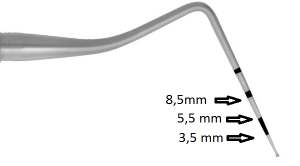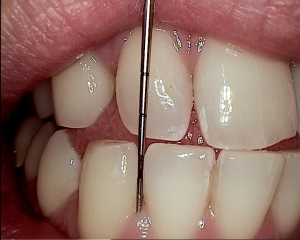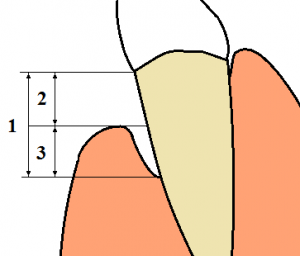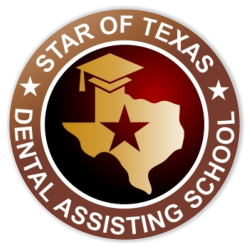As we get closer to the holidays and the end of another 12-week session, let’s take a look at some of the subjects our students have learned about these past 12 weeks.
In week nine, Star of Texas dental assistant students learn about Endodontics, Periodontics and Oral Surgery.
Our students found the chapter on Periodontics very interesting. Many people are not aware of their periodontal health or fail to receive treatment.
Let’s take a look at what Periodontics involves and why it is so important to visit your dentist regularly to check for periodontal health.
 If you were to view a cross-section of the tooth and jaw, you would see, from the tip of the tooth toward the gingiva (gum), the following: the enamel-covered portion of the tooth getting wider, then constricting as it approaches the gingival area; the margin of the gingival tissue (which just abuts the tooth); the gingival tissue that is firmly bound down to the underlying bone and cannot be moved, perhaps with a pebbly appearance; and smoother looking gingival tissue, which is very movable and not tightly bound down to the underlying bone. The last area may be redder in color than the other described gingival tissue and leads to the cheeks and lips.
If you were to view a cross-section of the tooth and jaw, you would see, from the tip of the tooth toward the gingiva (gum), the following: the enamel-covered portion of the tooth getting wider, then constricting as it approaches the gingival area; the margin of the gingival tissue (which just abuts the tooth); the gingival tissue that is firmly bound down to the underlying bone and cannot be moved, perhaps with a pebbly appearance; and smoother looking gingival tissue, which is very movable and not tightly bound down to the underlying bone. The last area may be redder in color than the other described gingival tissue and leads to the cheeks and lips.
The focus of this topic is on the zone of attached gingiva. As part of your periodontal exam, your dentist uses a periodontal probe to measure and record the depth of the sulcus. The sulcular depth is the depth of the space between the marginal gingiva and the tooth. The periodontal probe used to measure this sulcus is gently inserted into the margin of the gingiva and placed into the sulcus until it is stopped by the gingival tissue, which is more tightly bound to the bone. This measurement helps to determine your periodontal health. Hopefully, the sulcular depths measured were 3 millimeters or less. This tightly attached zone of gingival tissue surrounding the tooth is quite important.
uses a periodontal probe to measure and record the depth of the sulcus. The sulcular depth is the depth of the space between the marginal gingiva and the tooth. The periodontal probe used to measure this sulcus is gently inserted into the margin of the gingiva and placed into the sulcus until it is stopped by the gingival tissue, which is more tightly bound to the bone. This measurement helps to determine your periodontal health. Hopefully, the sulcular depths measured were 3 millimeters or less. This tightly attached zone of gingival tissue surrounding the tooth is quite important.
 This zone of attached gingiva needs to be intact and of adequate width to protect (by separating) the tissue around the tooth. If it is not sufficient, improper (too hard) brushing or a muscle attachment that is not in a proper position can pull on the attached gingival tissue. If it pulls enough, the 1-3 millimeter normal depth can increase to 4 millimeters, or even 6 millimeters or more. This will not be a stable or healthy change in your periodontal health. The normal gingival margin (gumline) is scalloped (like small, regular waves). If there is insufficient attached gingiva, the scalloping will be altered, and the gingiva will turn red and bleed easily. The pulled area will be more prone to trapping bacterial plaque and food debris, will be harder to clean, and will always be more inflamed and infected. If you have this problem, you might have even seen this yourself. It can lead to early tooth loss. Insufficient attached gingiva is not good and needs to be corrected.
This zone of attached gingiva needs to be intact and of adequate width to protect (by separating) the tissue around the tooth. If it is not sufficient, improper (too hard) brushing or a muscle attachment that is not in a proper position can pull on the attached gingival tissue. If it pulls enough, the 1-3 millimeter normal depth can increase to 4 millimeters, or even 6 millimeters or more. This will not be a stable or healthy change in your periodontal health. The normal gingival margin (gumline) is scalloped (like small, regular waves). If there is insufficient attached gingiva, the scalloping will be altered, and the gingiva will turn red and bleed easily. The pulled area will be more prone to trapping bacterial plaque and food debris, will be harder to clean, and will always be more inflamed and infected. If you have this problem, you might have even seen this yourself. It can lead to early tooth loss. Insufficient attached gingiva is not good and needs to be corrected.
Once diagnosed, the correction is relatively easy. It will require minor periodontal surgery. Usually, a periodontist (gum specialist) will be asked to perform this procedure. You will receive a local anesthetic to numb the area, and the problem tissue area will be reshaped and formed to give back the correct width of attached gingival tissue.
While this is a relatively common problem, patients do not commonly recognize it. If you have it diagnosed, get it fixed as soon as possible. You will save yourself from many future problems.
If you have any questions about insufficient attached gingiva, please feel free to ask us at Star of Texas Dental Assisting School.
(512) 487-1547; operations@staroftexasdentalassistingschool.com
We are currently enrolling for our December 2015 session. Please contact one of our Admissions Representatives if you are interested in attending our 12 week dental assistant training program. Classes are held only on Saturdays! (512)487-1547

